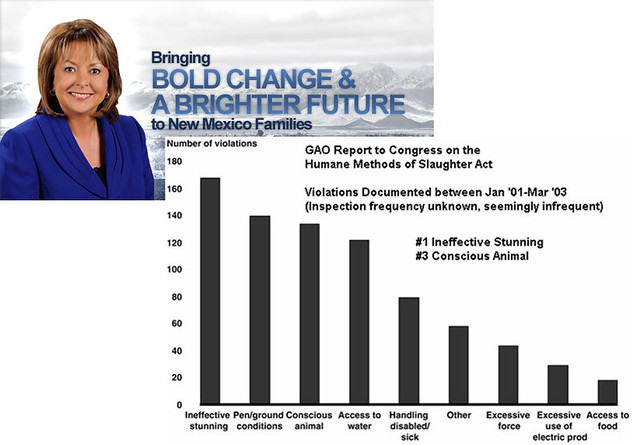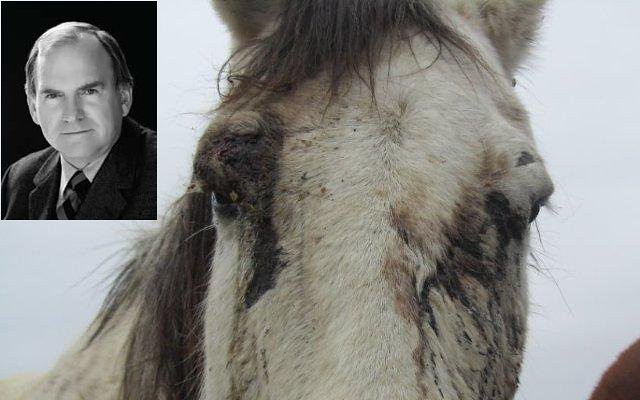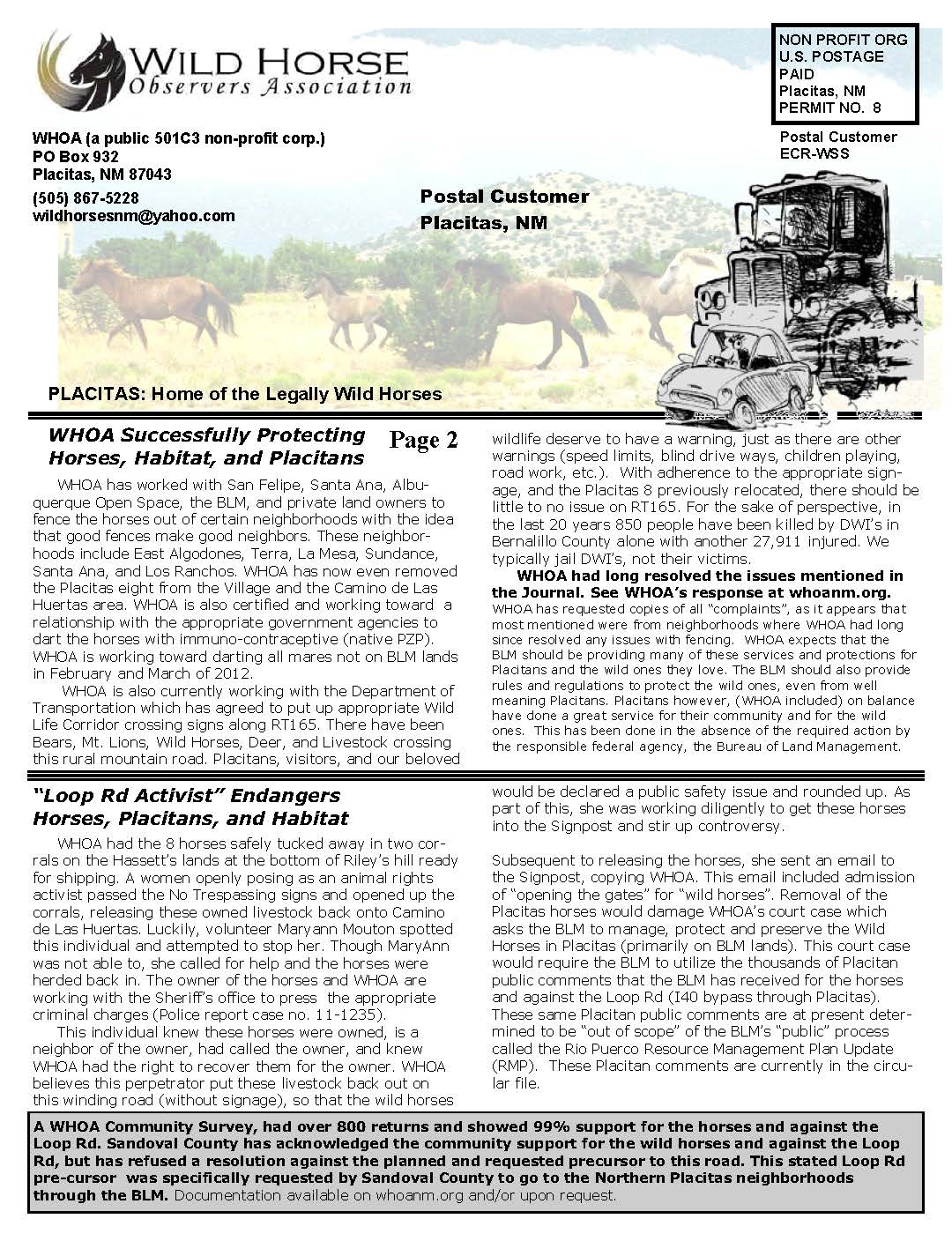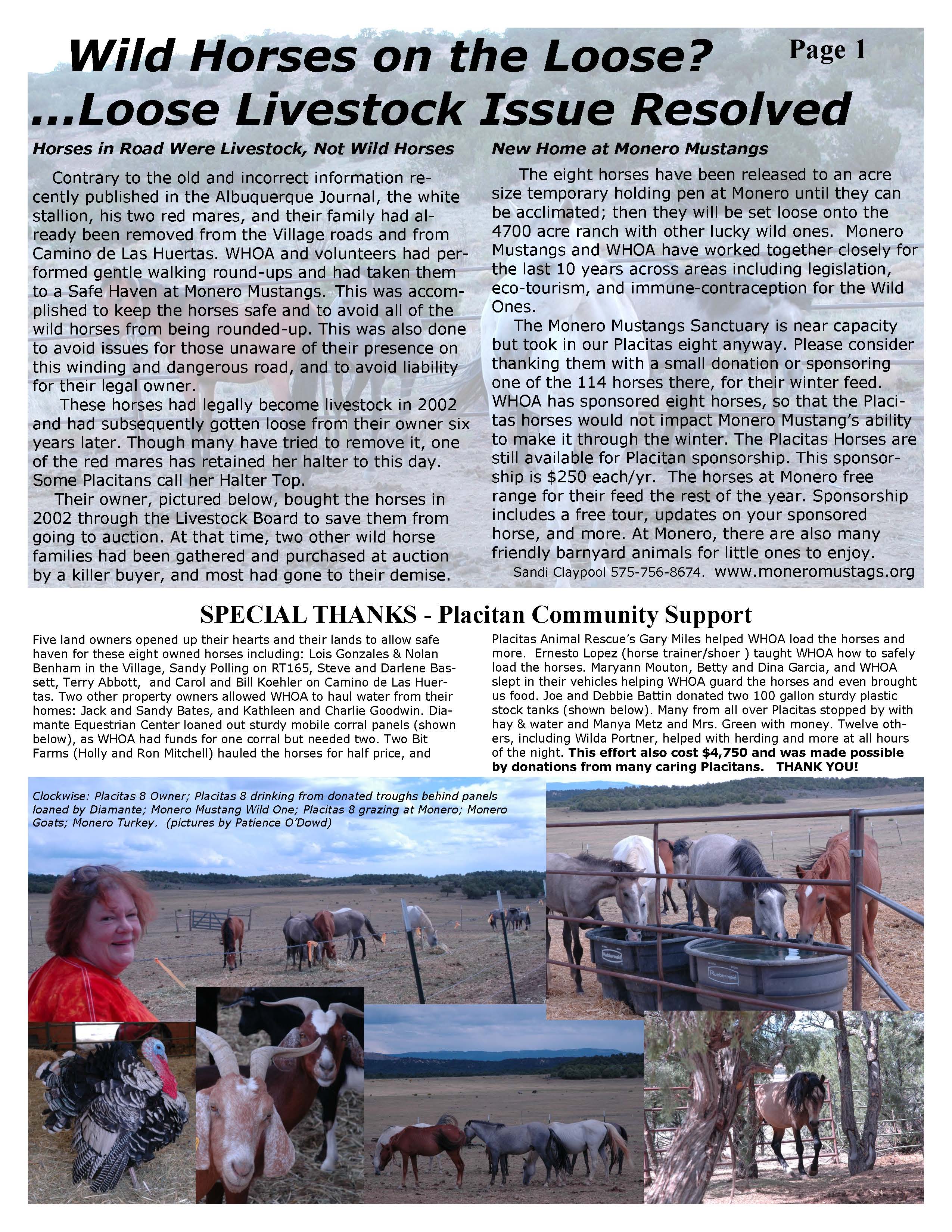With less than 500[1] wild horses remaining on all New Mexico’s federal lands, down from over 7,500 in 1974[2], and with an average of only 71 abandoned  horses/yr[3] estrayed across the entire state of New Mexico over the last 6 years, you  may ask, “Where is this “Booming Population†of “feral and free roaming horses†in New Mexico? Where are the “tens of thousands†from “individual†accounts? Where are the environmental damage reports?
We do have free roaming horses in Placitas, we are the exception. When you drive through New Mexico you will rarely see a free roaming horse. More about the Placitas horses later!
The tables below will give you the real story of the roaming horse population in New Mexico. The First American Nations are not included because there has been no survey here. I have included the cattle population, not to embarrass, but to provide an educational perspective. The truth of it is, there are very few wild horses left here in New Mexico.
Horses and Cattle on NM Public Lands
| NM Land Type |
Target No. Horses |
Acres |
No. Cattle |
Acres |
| NM State Lands[4] |
0 |
0 |
171,011 |
8,700,000 |
| NM BLM Lands[5]Socorro |
70 |
16,493 |
185,023 |
12,800,000 |
| NM FSÂ Lands Jarita Mesa[6] |
20-70 |
55,000 |
70,618 |
9,100,000 |
|
NM FS Lands Jicarilla[7] |
50-105 |
76,000 |
 |  |
|
Total Horses |
Less than 500 |
Total Cattle |
426,652 |
 |
We have all been hearing various accounts of all the abandoned horses around the state. The table below shows the actual data printed from the New Mexico Livestock Board Estray Data Base. This table shows that over the last 6 years, the number of abandoned horses has been relatively stable, with small spikes in 2008 and 2009. This is far from a magnitude of thousands or even “tens of thousands†of horses mentioned in other articles!
NM ESTRAYSÂ Â (Abandoned/Lost Domestic Horses)*
| Year | 2006 | 2007 | 2008 | 2009 | 2010 | 2011 |
| No.Estrays | 59 | 40 | 114 | 99 | 58 | 55 |
| Avg= 71 | Â | Â | Â | Â | Â | Â |
*There may be some horses that qualify as State’s wild horses that get picked up as estrays.
The table below shows the actual numbers of horses in the US which have gone to slaughter[8]. It is important for New Mexicans to realize that there are 9 Million horses nation-wide.[9] Of these, only 1% go to slaughter. In fact, a 2012 poll conducted by Lake Research Partners[10] showed that 80% of American voters are opposed to the slaughter of U.S. horses for human consumption. The nationwide survey reveals that Americans oppose horse slaughter overwhelmingly.
US DOMESTIC HORSES to slaughter
| Year | 2006 | 2007 | 2008 | 2009 | 2010 | 2011 |
| Domestics | 142,740 | 122,459 | 134,059 | 106,542 | 112,904 | 133,241 |
Euthanaisa can cost $70.  As an alternative to land fill/burial- Renders pick up the animal at your home, 10-$70.
Environmental Aspects of Horses Hooves
The NM Cattle Growers Association & New Mexico Farm & Livestock Bureau made statements  in the last Signpost “ Horse hooves have an entirely different impact on the ground the travel than cloven hoofed animals, compacting the soil rather than breaking it.†with no supporting evidence or data referenced. Here then is another perspective by Craig Downer, Renown Wildlife Ecologist, Biologist, and author.
“Horses have soliped hooves that make them superb long-distance runners. They evolved for millions of years, mainly in North America, and contribute positively to the open-terrain ecosystems of this continent. Unlike the case with many cloven-hoofed grazers, their hooves do not cut up the soil and expose it to the destructive forces of wind and water erosion. By compacting the soil, horses actually help it resist wind and water erosion in many cases and also to retain soil moisture. As always, this depends on the horses being allowed to occupy suitably large areas and to disperse their grazing pressure over large areas, which is their nature. . .Few will acknowledge, for example, the great positive contribution made by horse feces in building rich, moist and nutrient-laden soils and in seeding many plant species.
Legal Designations
There are four legal categories of horses here in New Mexico.
- Wild Horses protected under the federal 1971 Act, present and unclaimed in 1971.[11]
- Â NM States Wild Horses protected under the New Mexico State statute 77-18-5. [12]
- Domestic horses which as Livestock are exempt from protection under the Animal Cruelty Law of NM. [13]
- Estrays which are domestic horses with unknown owner are exempted from protection as Livestock in New Mexico. [14]
Terms used such as feral, have no legal definition. No amount of feeding, or “tamingâ€, could change any of the legal designations of a horse. Feral refers to a specie being progeny of domestic animals at some point in time. Feral also seems to imply, that the Placitas horses are not legally wild.
Spanish or Not – This is culturally significant though not legally significant. Placitas horses have been DNA tested showing a large percentage of Spanish markers, see Signpost Article by Margo DeMello.
GAO Reports
GAO reports abound on Equine Issues and The Humane Slaughter Act. These reports overall, and individually, state two basic facts/recommendations regarding horses and slaughter; I. The recommendation to end horse slaughter.[15] II. 13.2 Million acres of Public lands legally designated as Wild Horse Areas in 1971have been zeroed out[16].
The Placitas Horses – Questions of the Day!
Yes, we do have free roaming horses in many areas of Placitas.
Fencing– WHOA has had them fenced out of La Mesa, Sundance, Los Ranchos subdivisions, a La Farge Pit, and many homes in Placitas. Last summer WHOA worked with San FelipePueblo to fence the horses out of the East side of I25 Algodonas, thus keeping them off the dead ended frontage road there. San Felipe also fixed their entire fence line along the BLM lands in Placitas.
Water-Â WHOA does help supply water for the horses along with many Placitans.
Feeding – All wildlife should be observed from afar and respected for mutual safety. Even horses raised in captivity can  learn to bite and  kick. Please don’t teach a wild horse to eat from  your hand, even and especially the babies. WHOA discourages any feeding from the hand or pockets as this emboldens a horse rather than teaching or maintaining necessary boundaries important for their own future. WHOA has historically discouraged feeding. That said, the authorities have essentially blocked WHOA from managing their population through immuno-contraception, our population has grown and a warm dry summer is upon us.
Population Management – Neither round-ups nor population control by contraception would be required in nature. However the US Dept of Ag spends $100 million/yr[17] killing off predators utilizing sodium cyanide banned in other countries. That cost is more than is spent on the entire Wild Horse and Burro program 75.7 million/yr[18].  Add to that trappings, hunting, lengthening hunting seasons here in NM for New Mexico’s Bears and Cougars, and nature may need a hand with immuno-contraceptives. WHOA participated in the protest for Bear Watch just this week.
Lawsuit Status – WHOA filed suit May 2011 against the Department of the Interior (BLM) and a private citizen. All briefs have been filed and responded to and we are now waiting for a ruling from the judge. We expect that there will be a ruling towards the end of the summer.
FREE FILM! – STAMPEDE TO OBLIVION Sat July 14th @ 2:00PM – Albuquerque Main Library – 501 Copper Avenue NW – 505.768.5141. By Peabody award-winning George Knapp of KLAS news.[19] Bring your questions! There will be discussions and a question and answer period.
[1] Target numbers are from the Environmental Assessments. Populations vary around these targets. Targets doubled = less than 500.
[2]Â Ninth Report to Congress on Administration of the Wild Free-Roaming Horse and Burro Act USDOI BLM, USDA Forest Service
[3]Â NMLBÂ Data Base query through a Wild Horse Observers Association (WHOA) Inspection of Public Records request.
[4] Calculated from NM State Lands grazing revenue of $5.910,144 Million divided by $2.88/per month per cow using 12 months. Revenue and grazing fee from Karin Stangl Assistant Commissioner of Communications New Mexico State Lands Office. Note; 84% is utilized for education. K.S. Most grazing is for cultural purposes. Ray Powell.
[5] http://www.blm.gov/public_land_statistics/pls10/pls10_combined.pdf Divided Total AUM’s by conservative 10 months grazing.
[6] http://www.fs.fed.us/rangelands/ecology/wildhorseburro/territories/Jarita.shtml
[7] http://www.fs.fed.us/rangelands/ecology/wildhorseburro/territories/Jicarilla.shtml
[8] USDA statistics courtesy of Darrell Charlton, Jr. and Equine Welfare Alliance.
[9] http://habitatforhorses.org/absence-horse-slaughter-plants-caused-increase-abuse-neglect-abandonment-horses/
[10] http://www.aspca.org/Pressroom/press-releases/020112
[11] http://www.wildhorseandburro.blm.gov/92-195.htm
[12] http://www.conwaygreene.com/nmsu/lpext.dll?f=templates&fn=main-hit-h.htm&2.0Â Statutes, Rules and Const./NMSAÂ (Unannotated)/CHAPTER 77 Animals and Livestock /ARTICLE 18 General Animal Regulations /77-18-5. Wild horses
[13] NM State Statute 30-18-1.I Cruelty to animals; penalties; exceptions
[14] http://www.conwaygreene.com/nmsu/lpext.dll?f=templates&fn=main-hit-h.htm&2.0Â Statutes, Rules and Const./NMSAÂ (Unannotated)/CHAPTER 77 Animals and Livestock /ARTICLE 2 Livestock Board /77-2-1.1.
[15] http://www.gao.gov/new.items/d11228.pdf. “What GAO Reccomends†“consider a permanent ban on horse slaughterâ€
[16] http://www.gao.gov/new.items/d0977.pdf GAO-09-77  “… the BLM owned acreage managed for wild horses and burros has changed from 42.2 million acres to 29.0 million acres, a difference of 13.2 million acres.†Pg. 88
[17] http://www.nrdc.org/wildlife/animals/wolves/predatorcontrol.asp
[18] http://www.doi.gov/news/pressreleases/2010_02_01_release.cfm





